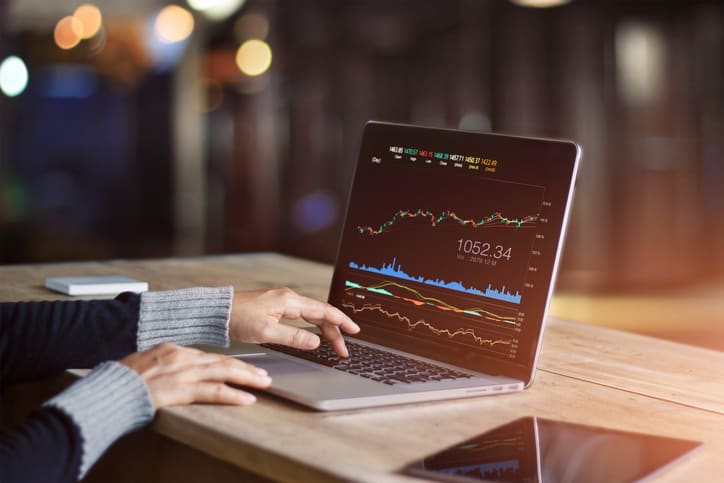It’s been a roller-coaster ride on the global stock markets so far in 2022 with the FTSE 100 dipping below 7,000 points for the first time in six months. But there’s been some good trading news for investors in the last fortnight given the index’s 8% rise to over 7,400 points.
Despite the challenging trading environment, some savvy shareholders are sitting on substantial returns. The FTSE All-Share may have risen by only 7% in the last year, but some stocks have delivered returns of up to 120%. Let’s take a closer look at the stocks delivering the highest gains for shareholders.
[top_pitch]
Which shares made the ‘top 10 risers’ list?
According to Investors Chronicle, these stocks provided the highest returns in the FTSE All-Share over the last year (as of 15 March 2022).
|
Company (and ticker) |
Price (p) |
Return (%) |
|
Riverstone Energy (RSE) |
634.0 |
121.7 |
|
Indivior (INDV) |
269.8 |
118.5 |
|
Investec (INVP) |
439.8 |
91.2 |
|
Airtel Africa (AAF) |
143.0 |
79.2 |
|
John Menzies (MNZS) |
512.0 |
77.2 |
|
Drax (DRX) |
701.5 |
72.5 |
|
SLF Realisation Fund C (SLFX) |
10.1 |
69.2 |
|
Safestore (SAFE) |
1245.0 |
66.1 |
|
Sanne (SNN) |
914.0 |
64.4 |
|
Glencore |
460.3 |
61.5 |
There are some interesting points to note from this list:
- Eight of the top risers sit outside the FTSE 100, and three outside the FTSE 250. Small-cap stocks tend to be hit harder by market downturns but, equally, can offer more upside than large-cap stocks. The fund manager Fidelity International comments that “small-cap stocks may offer significant growth potential to long-term investors who can tolerate volatile stock price swings in the short term.”
- The companies operate in a wide range of sectors, including pharmaceuticals, banking, telecoms, aviation, energy, storage, IT and mining.
- Two of the companies, Riverstone Energy and SLF, are investment trusts that invest in underlying assets.
What can we learn about the four highest risers?
1. Riverstone Energy
The top riser is Riverstone Energy, an investment trust in the global energy sector. It has a particular focus on decarbonisation and sustainable energy. Riverstone consistently trades on a 30%-50% discount to its net asset value and is currently trading at a discount of 30%.
It’s delivered a stellar 122% return for shareholders in the last year. However, it’s been a very rocky ride. According to Morningstar, the company made losses in each of the four years up to 2020 and is still trading at its lowest price in nearly 10 years.
2. Indivior
In second place is Indivior plc, a global pharmaceutical company trading in the FTSE 250 but headquartered in the US. Indivior recently returned to profitability, driven by strong growth in demand for Sublocade (a drug to treat opioid abuse).
Indivior has faced substantial challenges since its demerger from Reckitt Benckiser in 2014. As a result, it’s slowly climbing back towards its share price high of over 490p in 2018. This has been helped by its $600 million (3461 million) settlement with US authorities over the marketing of Suboxone. It’s currently trading around 270p, still some way below its peak.
3. Investec
South African bank Investec plc is another recovery story. Before the pandemic, Investec was already facing financial pressure due to the weak economy in South Africa and Brexit uncertainty hitting its UK business. Since then, operating profit has remained substantially below its 2019 level.
However, Investec recently lifted its full-year profits guidance to £642-£683 million. This would be a significant increase of 70%-80% from its operating profit in 2020. According to Investing.com, the average 12-month share price forecast from analysts is 480p. Given that Investec is currently trading around 460p, this would suggest only limited upside potential.
4. Airtel Africa
Telecommunications provider Airtel Africa is one of the largest companies on the list. It qualified for the FTSE 100 in January 2022, with a market capitalisation of £5.5 billion. Since its listing in 2019, it’s consistently delivered strong profits growth in its African markets.
Investors looking for a passive income might also be attracted by its dividend yield of nearly 2%. However, it’s currently trading at a price to earnings ratio of 21. That’s a high P/E ratio compared to other telecoms companies, including Vodafone (19), Verizon (10) and AT&T (8).
Sharecast reports that the two most recent brokers’ 12-month price forecasts are 190p-195p. Given Airtel is currently trading at 148p, this might suggest future upside potential.
[middle_pitch]
What else should you consider when trading?
You can use your ISA allowance of £20,000 per year for share trading, ensuring that any gains are tax-free. If you’re trying to decide between ISA platforms, our experts have compiled a list of our top-rated ISA providers.
Alternatively, you may be looking for a low-cost share trading account. To save you time and money, we’ve provided a guide to our top-rated share dealing accounts. Amongst other things, we’ve compared fees, choice of investments and ease of use.
As with all share trading, remember that past performance is not a reliable indicator of future performance.







